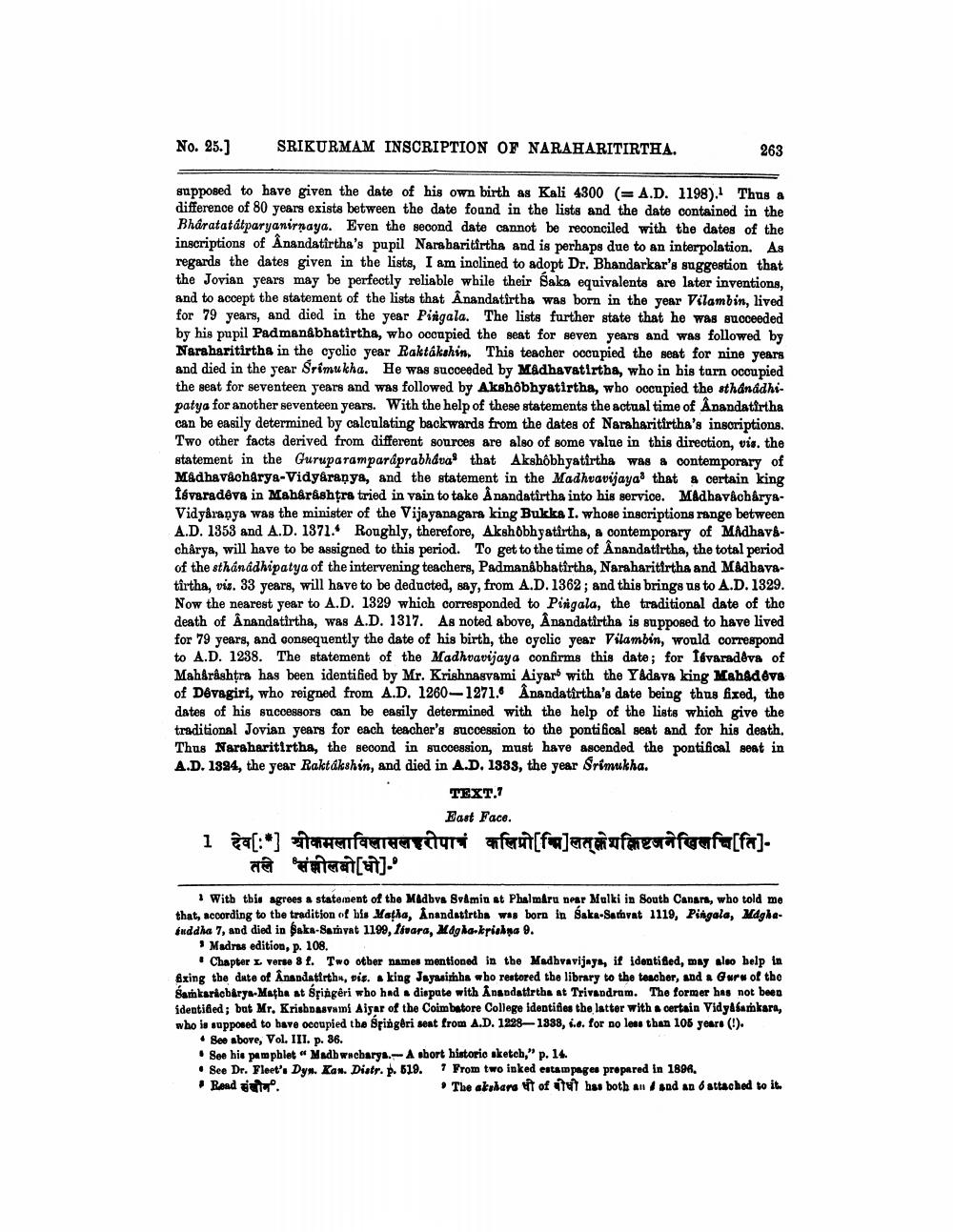________________
No. 25.)
SRIKURMAM INSCRIPTION OF NARAHARITIRTHA.
263
supposed to have given the date of his own birth as Kali 4300 ( A.D. 1198). Thus a difference of 80 years exists between the date found in the lists and the date contained in the Bharatatátparyanirnaya. Even the second date cannot be reconciled with the dates of the inscriptions of Anandatîrtha's pupil Narabaritirtha and is perhaps due to an interpolation. As regards the dates given in the lists, I am inclined to adopt Dr. Bhandarkar's suggestion that the Jovian years may be perfectly reliable while their Saka equivalents are later inventions, and to accept the statement of the lists that Anandatirtha was born in the year Vilambin, lived for 79 years, and died in the year Pingala. The lists further state that he was succeeded by his pupil Padmanabhatirtha, who occupied the seat for seven years and was followed by Narabaritirtha in the cyclic year Raktákahin. This teacher occupied the seat for nine years and died in the year Srimukha. He was succeeded by Madhavatirtha, who in his tarn occupied the seat for seventeen years and was followed by Akshobhyatirtha, who occupied the sthånádhipatya for another seventeen years. With the help of these statements the actual time of Anandatirtha can be easily determined by calculating backwards from the dates of Naraharitirtha's inscriptions. Two other facts derived from different sources are also of some value in this direction, vis, the statement in the Guruparampardprabhava' that Akshobhyatirtha was a contemporary of Madhavacharya-Vidyaranya, and the statement in the Madhravijayad that a certain king Isvaradeva in Maharashtra tried in vain to take Ånandatirtha into his service. MadhavacharyaVidyaranya was the minister of the Vijayanagara king Bukka I. whose inscriptions range between A.D. 1353 and A.D. 1371. Roughly, therefore, Akshobhyatirtha, a contemporary of Madhav - chårya, will have to be assigned to this period. To get to the time of Ânandatirtha, the total period of the sthánadhipatya of the intervening teachers, Padmanabhatirtha, Naraharitirtha and Madhavatirtha, vis. 33 years, will have to be deducted, say, from A.D. 1362; and this brings us to A.D. 1329. Now the nearest year to A.D. 1329 which corresponded to Pinigala, the traditional date of the death of Anandatirtha, was A.D. 1317. As noted above, Anandatirtha is supposed to have lived for 79 years, and consequently the date of his birth, the cyclic year Vilambin, would correspond to A.D. 1238. The statement of the Madhvavijaya confirms this date; for Isvaraddva of Maharashtra has been identified by Mr. Krishnasvami Aiyar with the Yadava king Mahadeve of Devagiri, who reigned from A.D. 1260-1271.6 Anandatirtha's date being thus fixed, the dates of his successors can be easily determined with the help of the lists which give the traditional Jovian years for each teacher's succession to the pontifical seat and for his death. Thus Naraharitirtha, the second in succession, must have ascended the pontifical seat in A.D. 1894, the year Raktákshin, and died in A.D. 1938, the year Srimukha.
TEXT.7
East Face. 1 [:*] inhalfaurari afara[fa]emateufeemafoafa[fa]
để chitect[]->
* With this agrees a statement of the Madbva Svåmin at Phalmaru near Mulki in South Canans, who told me that, according to the tradition of his Matha, Anandatirtha was born in Saka-Samrat 1119, Pingala, Maghefuddha 7, and died in Saka-Samyat 1199, favara, Xagka-krishna 9.
Madras edition, p. 108.
. Chapter L verse 8 f. Two other names mentioned in the Madhvavijays, if identified, may also belp in &xing the date of Anandatirths, pis. king Jayasimha who restored the library to the teacher, and a Guru of the Šankaracharya-Matha at Sringeri who had dispute with Ansodatirtha at Trivandrum. The former has not been identified; but Mr. Krisbasvami Aigar of the Coimbatore College identifies the latter with a certain Vidyasankara, who is supposed to have occupied the Bringbri seat from A.D. 1228-1338, 1.o. for no less than 100 years (!).
• See above, Vol. III. p. 86. • Sen hio pamphlet " Madb wacharys. A short historio sketch," p. 14. • See Dr. Fleet'. Dyn. Kan. Distr. p. 519. 7 From two inked estampages prepared in 1896. Read det
The skuhara dit of it it has both an and an 6 attached to it.




